EMR Adoption Climbing and Expected to be Strong over the next Five Years
The deadline for the Health Information Technology for Economic and Clinical Health (HITECH) Act has many scrambling to adopt EMR systems before that deadline in order to qualify for the funding. Incentive funding via HITECH to hospitals and physicians to adopt Electronic Medical Records (EMRs)will stop in 2014. A pot of $19 billion of incentives is currently acting as a strong driver to encourage EMR adoption. But many believe that once the number of EMR systems rolled out spikes in adoption rates in 2013, without further incentives, the market is likely to stagnate after that.
A report by Frost and Sullivan on the EMR market notes that “Providers of hospital IT infrastructure are showing great urgency in rolling out solutions, especially due to the rudimentary levels of the current IT infrastructure, and given the short implementation deadlines (roughly 2011 to 2015) set by the government.”
 But just because HITECH incentives will be phased out may not necessarily mean that the market will stagnate. A report by Toronto-based Millennium Research Group (MRG) expects there to be strong growth in the area of EMR implementations past 2012 through 2016. The group estimates that EMR software will grow annually at a rate faster than 12 percent. By 2016, EMR market revenues are expected to top $8.3 billion. MRG thinks that despite the loss of incentive funding, new rules by Medicare which mandates electronic records will continue to prop up demand for the systems.
But just because HITECH incentives will be phased out may not necessarily mean that the market will stagnate. A report by Toronto-based Millennium Research Group (MRG) expects there to be strong growth in the area of EMR implementations past 2012 through 2016. The group estimates that EMR software will grow annually at a rate faster than 12 percent. By 2016, EMR market revenues are expected to top $8.3 billion. MRG thinks that despite the loss of incentive funding, new rules by Medicare which mandates electronic records will continue to prop up demand for the systems.
SK&A, A Cegedim Company and a leading provider of healthcare information solutions and research, in a recent survey found that the EMR adoption rate already has exceeded 40 percent. Adoptions rates were higher for physicians in large practices compared to those in smaller ones. Sole-practitioner offices had reached a 30 percent adoption rate while 75 percent of offices with 26 or more physicians are now using EMRs. Offices with only a single examination room had achieved 28 percent adoption, while offices with more than eleven examination rooms had a 64 percent adoption. Similarly offices seeing just 50 patients on a daily basis had 36 percent adoption, while those offices seeing more than 100 patients per day have 66 percent adoption.
Source: www.formtek.com; By Dick Weisinger; December 30th, 2011




Leave a Reply
Want to join the discussion?Feel free to contribute!